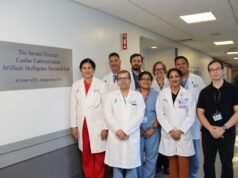
By Ronald P Caputo
The aim of a vascular robotic system is to help interventional cardiologists perform percutaneous coronary intervention (PCI) procedures with greater precision. The systems are designed to provide greater accuracy of lesion measurement, aid in better advancement of guidewires, and help ensure correct placement of stents—which, all together, can lead to less instances of additional stent placement per lesion. For example, robotic systems allow for sub-millimetre movements to place stents and balloons, and can advance or retract guide wires with movements as small as a millimetre.
The precision afforded by these capabilities is greater than what can be achieved manually or using only visual estimates. Potentially, these subtle movements could mean the difference between a successful cardiac catheterisation procedure and one that requires secondary stent placement or a second procedure at a later date due to restenosis. Greater precision in stent placement is certainly warranted—using traditional PCI methods, up to 47% of stents longitudinal geographic miss using traditional methods1. These procedure variations can have a big impact on the incidence of target vessel revascularisation.
With a robotic system, the interventional cardiologist performs the PCI procedure from a “cockpit” rather than being next to the patient. The cockpit contains displays to visualise the procedure, and provides controls for the physician to manipulate the movement of interventional devices such as the guidewire and balloon/stent catheters via the bedside-mounted robotic arm. In my experience, I have found that performing PCI procedures from the cockpit also reduces physical fatigue from standing and leaning over the patient during the procedure.
Additionally, the cockpit’s radiation shielding eliminates the need for physicians to wear the heavy and cumbersome lead aprons used in traditional PCI procedures to protect against radiation exposure. Furthermore, the location of the cockpit in the cath lab provides radiation protection because it is positioned several feet away from the patient and the fluoroscopy unit (but is close enough to enable verbal contact between the patient and staff). The PRECISE study (sponsored by Corindus Vascular Robotics), released in April of 2013, showed that radiation exposure for the physician was reduced by 95.3% from traditional manual procedures; for patients, a reduction in radiation is afforded by the robot by a shortened procedure length. Personally, I welcome the introduction of a technology that will allow us to remove the threat of radiation during every procedure.
I have found that patients are comfortable with the increasing amount of technology that is used in care delivery, and are open to the use of vascular robotic systems provided they are informed about how they are used as well as the benefits they will receive from it. Because of the benefits brought by robotic assistance, I envision that the use of vascular robotic systems will expand into other cardiac procedures (eg. chronic total coronary occlusion, peripheral vascular disease and structural heart conditions) due to the increased level of precision that is offered. However, the key to increased industry acceptance and expansion of use lies with the level of commitment from the full cardiac catheterisation team: a commitment must be made to learning a new skill, training effectively and consistently using the technology.
Ronald P Caputo, interventional cardiologist, St. Joseph’s Hospital Health Centre, Syracuse, USA
Reference
1. Costa, MA. Am J Cardiol 2008; 101: 1704–11










